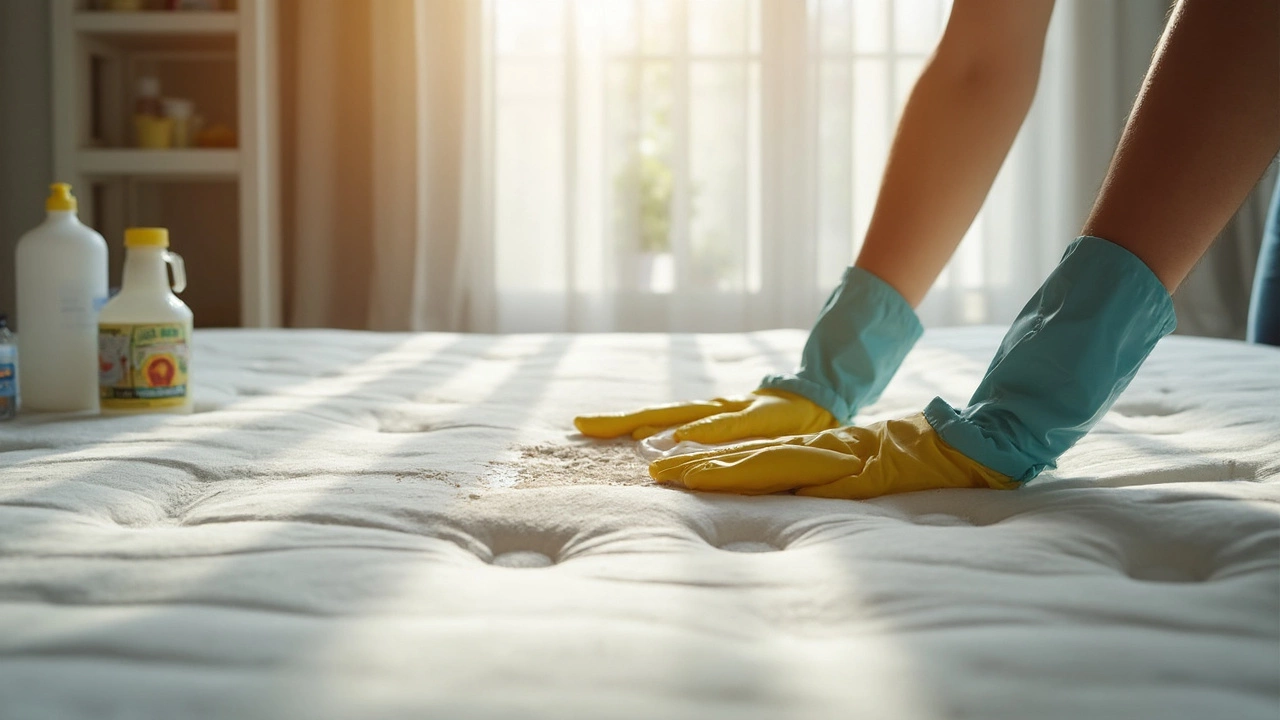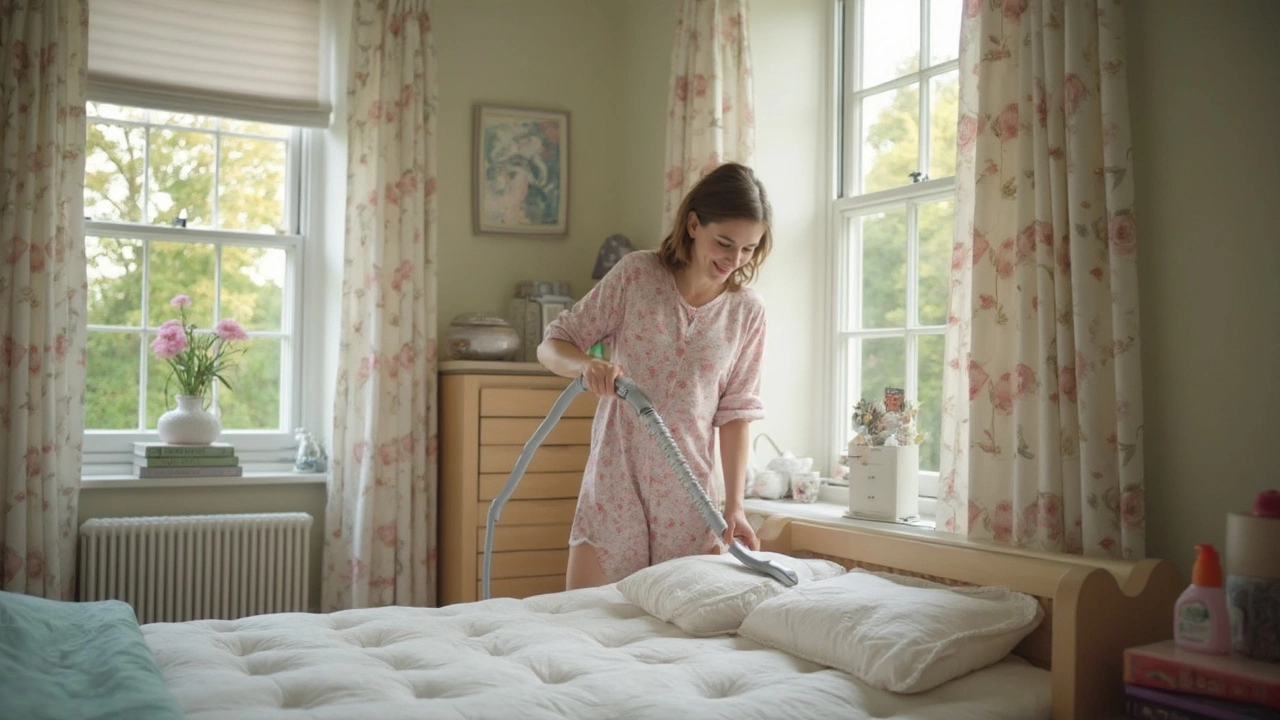Ever noticed your mattress starting to smell funky or build up mystery stains? It’s not just you—every mattress gets dirty, even if you change sheets every week. Sweat, skin cells, pet fur (thanks, Charlie), and that midnight snack accident all add up. When you let the mess sit, it can attract dust mites and crank up allergies.
The good news? You don’t need fancy sprays or pricey gadgets to turn things around. Some of the most effective cleaning hacks use stuff you already have at home. I’m talking baking soda, a vacuum, maybe a little white vinegar. The kicker is knowing how to use them right, so you get a mattress that actually smells and feels fresh—not just sprayed with Febreze.
If you can make your bed, you can clean your mattress. Sure, the first time might take longer, but once you see (and smell) the difference, you’ll want to keep these tricks in your regular routine. Ready to save your mattress (and maybe your nose)? Let’s get straight into the practical steps.
- Why Your Mattress Gets So Dirty
- Quick Mattress Cleaning Prep
- Hacks for Tackling Stains and Smells
- Deep Cleaning Without Fancy Gear
- Keeping Your Mattress Fresh Longer
Why Your Mattress Gets So Dirty
You might think your sheets protect your bed, but a mattress is like a giant sponge for life's messes. It grabs onto sweat, dead skin flakes, dust, and even crumbs from that late-night snack you swore you'd never eat in bed. Most of us spend about a third of our lives in bed—that's a lot of time to shed all sorts of stuff right into the surface you sleep on.
Pets, like my dog Charlie, love to sneak up on the bed, too. Their fur, dander, and little accidents only make things worse. Add in everyday dust from the room, and it starts to build up fast. If you've got allergies or wake up with a stuffy nose, your mattress could be the main reason.
- mattress cleaning is important because a dirty mattress holds sweat, oil, and thousands of dead skin cells (an average person sheds about 1.5 grams of skin a day, and dust mites love to eat that stuff).
- Studies show a mattress can double in weight after 10 years just from the build-up of debris inside—pretty nasty to think about.
- Kids, pets, and food spill accidents can leave stains and even start mold or mildew growth if moisture sticks around.
Just check this table to see what you might be sharing your bed with after a while:
| What Gets Trapped | Why It's a Problem |
|---|---|
| Sweat & Body Oils | Create stains and odors, attract bacteria |
| Dead Skin | Main food for dust mites |
| Dust Mites | Cause allergies and asthma |
| Pet Hair & Dander | Triggers allergies, especially if pets sleep with you |
| Food Crumbs | Attract bugs and create more stains |
| Mold/Mildew (from moisture) | Bad smells and can contribute to breathing issues |
So, if you notice weird smells or wake up feeling gross, it's not just "in your head." Your mattress needs some cleaning love. The earlier you tackle the gunk, the easier it is to keep your mattress fresh and your sleep healthy.
Quick Mattress Cleaning Prep
You don't need to block out your whole afternoon to get set up for mattress cleaning. A few smart moves before you start can save you a lot of headache later. Here’s what gets the job done quickly and actually works.
First off, strip all bedding. Toss sheets, pillowcases, and mattress covers straight into the wash. Most mattresses can collect nearly a million dust mites in just a year, according to the American Academy of Allergy, Asthma & Immunology. Getting those out of the way gives you a clear surface to work with.
Grab the following items so you aren’t running back and forth:
- Vacuum with upholstery attachment
- Baking soda
- White vinegar in a spray bottle (optional, great for stains)
- Clean towels or paper towels
- Mild dish soap (for tougher spots)
- Warm water
Don’t forget to crack open a window or switch on a fan. A little air flow helps with drying and cuts down on that musty smell mattresses can hold onto.
Setting up right also means knowing what *not* to do. Don’t soak your mattress—most are not built for tons of moisture. Water can get trapped inside and lead to mold. Spot clean, don’t drench!
Here’s a quick look at what you’ll need and why:
| Item | Why You Need It |
|---|---|
| Vacuum | Gets rid of surface dust and hair |
| Baking Soda | Neutralizes smells, pulls out moisture |
| Vinegar | Kicks stains and zaps odor |
| Dish Soap | Good for stubborn messes |
Use this simple mattress cleaning setup and you’ll be ready to tackle pretty much anything—crumbs, dog hair, mystery stains, you name it. Having your tools at arm’s reach keeps the whole thing quick and painless.

Hacks for Tackling Stains and Smells
Stains on a mattress seem to come out of nowhere, right? Stuff like sweat, coffee spills, or the occasional pet accident can leave marks and funky smells. But you can sort most stains and odors with basic household stuff—no need to splash out on fancy cleaners.
For fresh spills, always blot—never scrub—using a clean towel. Scrubbing just spreads the mess or pushes it deeper inside. Once you’ve soaked up what you can, grab a solution of equal parts water and white vinegar. Spray it straight on the stain, wait about 10-15 minutes, then dab it dry. Vinegar kills some bacteria and helps break down the smell at its source.
Old stains can be trickier, but baking soda is your secret weapon. Sprinkle a thick layer right over the spot. For heavy stains or smells, you can add a few drops of hydrogen peroxide to the area first (test a small part to make sure it won’t bleach). Wait a few hours—overnight is even better—then vacuum it all up. This trick sucks up both the stain residue and the odor trapped in the fabric.
If smells still hang around, try this step-by-step:
- Strip all bedding so nothing blocks your access.
- Sprinkle baking soda evenly over the whole surface.
- Let it sit for at least 3 hours to soak up odors.
- Vacuum slowly with a clean upholstery attachment.
Here’s a quick comparison of cleaning methods and what they work best for:
| Cleaning Method | Main Use | How Long to Wait |
|---|---|---|
| White Vinegar Spray | Fresh stains, sweat, some bacteria | 10-15 min before dabbing |
| Baking Soda | Odor soaking, light stains | 3-8 hours (longer is better) |
| Hydrogen Peroxide | Stubborn, protein-based stains | Let dry fully, check spot first |
Don’t forget: what you use on your mattress cleaning journey really does matter. Skip strong chemical sprays—they can be harsh and leave behind weird residues. And if you’re dealing with a big spill (like pet pee) don’t be afraid to do all of the above, in order, for the best shot at getting both stain and stench out.
Deep Cleaning Without Fancy Gear
You don’t need a high-end steam cleaner or special sprays to give your mattress a real deep clean. Most of the magic happens with stuff you already have—like baking soda, table salt, white vinegar, and your regular vacuum. Let’s walk through the drill so you’re not just pushing dirt around under the sheets.
First, strip off all your bedding, including pillowcases and mattress protectors. Toss them in the wash using the hottest water safe for the fabric—hot water wipes out dust mites and bacteria better than cold or warm settings. According to the CDC, washing at 130°F (54°C) or higher is best for killing dust mites.
Now, for the main mattress cleaning part. Get your vacuum and use the upholstery attachment. Go over the top, sides, and seams—don’t forget those little crevices where crumbs and pet hair collect. This lifts up dirt, dead skin, and allergens so your next steps actually reach the mattress surface.
Here’s the simple baking soda hack that actually works. Sprinkle a generous layer of baking soda over the whole surface. If you want an extra kick, add a few drops of essential oil (like tea tree or lavender) to the baking soda first. Let it sit at least 30 minutes—an hour is better if you can spare it. Baking soda grabs smells and pulls out moisture, which makes life harder for mold spores and bacteria.
If your mattress has stains, don’t ignore them. Mix a bit of dish soap, white vinegar, and water (about 1:1:2 parts), dampen a clean cloth, and dab the stained area. Avoid soaking—it’s a mattress, not a sponge. Blot gently—no crazy scrubbing—or you could drive the stain deeper.
- Strip all bedding and wash on hot
- Vacuum the mattress, paying close attention to seams
- Sprinkle baking soda and let it sit for 30–60 minutes
- Spot clean stains with mild dish soap/vinegar solution
- Vacuum again to remove baking soda
When the time’s up, vacuum up the baking soda really well. Take your time here; leftover powder can feel gritty. For extra freshness, let your mattress air out for a few hours with the window open if possible. Sunlight actually helps kill some germs and dries out any damp spots.
Here’s a handy snapshot that shows how just a basic deep clean can cut down the stuff lurking in your mattress:
| Method | Reduction in Dust Mites | Improvement in Odors |
|---|---|---|
| Vacuuming + Baking Soda | Up to 80% | High |
| Hot Water Bedding Wash | Up to 99% | Moderate |
| Spot Cleaning Stains | Minimal | Depends on stain |
So before you drop a chunk of cash on fancy gear, give this routine a shot. It’s cheap, simple, and actually does the job.

Keeping Your Mattress Fresh Longer
You just deep cleaned your mattress, but how do you make that fresh-feeling last? The secret is regular, low-effort upkeep. Trust me, it’s way easier to prevent grime than to wrestle with set-in stains after months of ignoring the mattress. I’m not talking rocket science—simple habits work best.
- mattress cleaning is easier if you use a mattress protector. A good one blocks sweat, spills, pet hair, and dust mites. Most can go straight in the washing machine once a month.
- Change and wash your sheets weekly. It’s the simplest way to cut down on dirt and oils working their way into the mattress.
- Give your mattress a quick vacuum every two weeks. Use the upholstery attachment if you’ve got pets or allergies—Charlie leaves fur everywhere and this trick really helps at my place.
- Every couple of months, sprinkle baking soda over the whole surface. Let it sit for 30 minutes, then vacuum it up to zap lingering smells.
- If it’s not raining, open the windows for a few hours. Fresh air helps break down odors and stops that stuffy smell from building up.
- Flip or rotate your mattress every 3-6 months. This spreads out the wear, keeps it comfier, and avoids those annoying dips and lumps.
Here’s a quick cheat sheet on how often you should actually do these things for max effect:
| Task | How Often |
|---|---|
| Wash Sheets | Weekly |
| Vacuum Mattress | Every 2 Weeks |
| Launder Mattress Protector | Monthly |
| Baking Soda Deodorizing | Every 2-3 Months |
| Rotate/Flip Mattress | Every 3-6 Months |
One last thing: try not to eat in bed. Crumbs attract bugs and make cleaning harder. If you slip up, just brush off the mess and vacuum soon after. Follow these habits, and your mattress won’t just look clean—it’ll feel and smell better for years.
